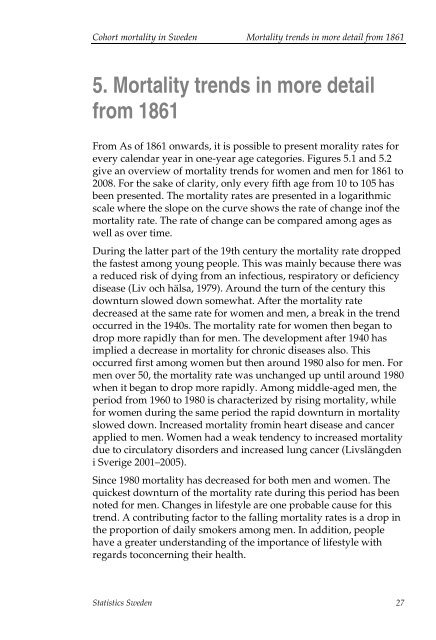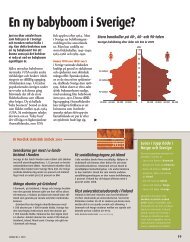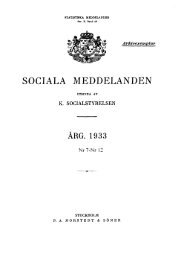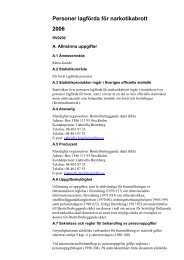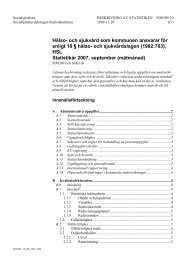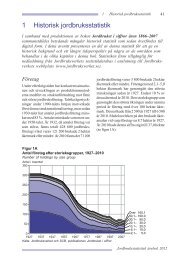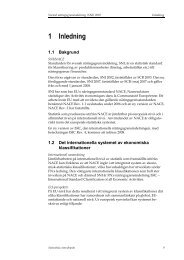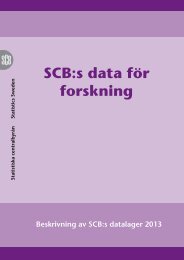Cohort mortality in Sweden (pdf)
Cohort mortality in Sweden (pdf)
Cohort mortality in Sweden (pdf)
Create successful ePaper yourself
Turn your PDF publications into a flip-book with our unique Google optimized e-Paper software.
<strong>Cohort</strong> <strong>mortality</strong> <strong>in</strong> <strong>Sweden</strong> Mortality trends <strong>in</strong> more detail from 18615. Mortality trends <strong>in</strong> more detailfrom 1861From As of 1861 onwards, it is possible to present morality rates forevery calendar year <strong>in</strong> one-year age categories. Figures 5.1 and 5.2give an overview of <strong>mortality</strong> trends for women and men for 1861 to2008. For the sake of clarity, only every fifth age from 10 to 105 hasbeen presented. The <strong>mortality</strong> rates are presented <strong>in</strong> a logarithmicscale where the slope on the curve shows the rate of change <strong>in</strong>of the<strong>mortality</strong> rate. The rate of change can be compared among ages aswell as over time.Dur<strong>in</strong>g the latter part of the 19th century the <strong>mortality</strong> rate droppedthe fastest among young people. This was ma<strong>in</strong>ly because there wasa reduced risk of dy<strong>in</strong>g from an <strong>in</strong>fectious, respiratory or deficiencydisease (Liv och hälsa, 1979). Around the turn of the century thisdownturn slowed down somewhat. After the <strong>mortality</strong> ratedecreased at the same rate for women and men, a break <strong>in</strong> the trendoccurred <strong>in</strong> the 1940s. The <strong>mortality</strong> rate for women then began todrop more rapidly than for men. The development after 1940 hasimplied a decrease <strong>in</strong> <strong>mortality</strong> for chronic diseases also. Thisoccurred first among women but then around 1980 also for men. Formen over 50, the <strong>mortality</strong> rate was unchanged up until around 1980when it began to drop more rapidly. Among middle-aged men, theperiod from 1960 to 1980 is characterized by ris<strong>in</strong>g <strong>mortality</strong>, whilefor women dur<strong>in</strong>g the same period the rapid downturn <strong>in</strong> <strong>mortality</strong>slowed down. Increased <strong>mortality</strong> from<strong>in</strong> heart disease and cancerapplied to men. Women had a weak tendency to <strong>in</strong>creased <strong>mortality</strong>due to circulatory disorders and <strong>in</strong>creased lung cancer (Livslängdeni Sverige 2001–2005).S<strong>in</strong>ce 1980 <strong>mortality</strong> has decreased for both men and women. Thequickest downturn of the <strong>mortality</strong> rate dur<strong>in</strong>g this period has beennoted for men. Changes <strong>in</strong> lifestyle are one probable cause for thistrend. A contribut<strong>in</strong>g factor to the fall<strong>in</strong>g <strong>mortality</strong> rates is a drop <strong>in</strong>the proportion of daily smokers among men. In addition, peoplehave a greater understand<strong>in</strong>g of the importance of lifestyle withregards toconcern<strong>in</strong>g their health.Statistics <strong>Sweden</strong> 27


